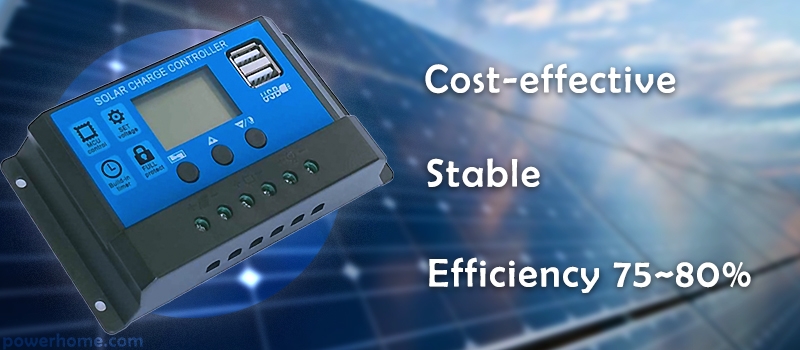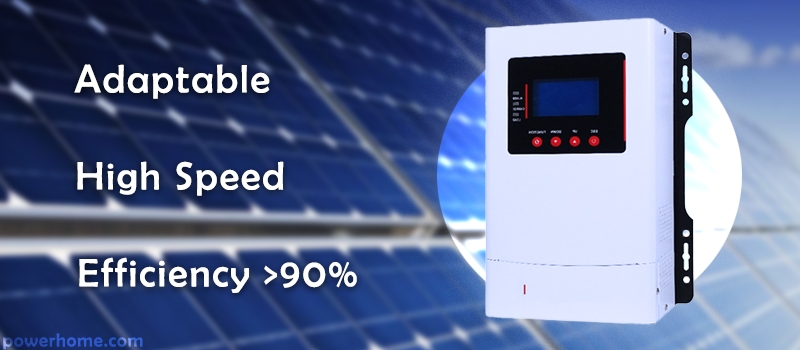Solar controller, fully known as solar charge/discharge controller, is an integral part of the photovoltaic power generation system, working together with solar panels, inverters and other components to power a home or factory. The popular solar charge controllers on the market are mainly PWM solar controllers and MPPT solar controllers. In order to help customers find out what kind of charge controllers are suitable for use, PowerHome will bring their detailed introductions.
Overview of Solar Charge Controllers
The earliest first-generation solar controller works by directly hooking up the output of the solar panel to the battery port and disconnecting it when the battery is full. Because of the internal resistance of the battery, it is difficult to fill the battery, and the charging conversion efficiency is only 70-76%. These products have been eliminated from the market, basically rarely used.
PWM solar controller using second-generation technology, is now the most common products on the market. Compared to the first generation of products, PWM solar charge controllers have advanced a lot and can solve the problem of battery dissatisfaction.
MPPT solar controllers use the third-generation technology and are the most high-end solar controllers. MPPT solar charge controllers are solar controllers with the "Maximum Power Point Tracking" function, and are the upgraded version of PWM solar controllers.
When designing solar charge controllers, a variety of factors need to be considered, such as the range of input and output voltages, the efficiency of maximum power point tracking, temperature compensation, and management of the battery state of charge. Together, these factors determine the performance and applicability of the controller. To learn more about the basics of solar charge controllers, please visit What is a Solar Charge Controller?
PMW Solar Charge Controller

Pulse Width Modulation (PMW) control mode is a kind of charge/discharge controller that automatically controls the output voltage and current according to the charging state of the battery by using the pulse width duty cycle, which can make full use of the photovoltaic power generation to charge the battery efficiently, and there is almost no wasted power. If the maximum power tracking (MPPT) circuit is set at the mating end with the PV module, the control efficiency of this type of controller can reach more than 97%.
As this kind of controller adopts pulsating current charging, the instantaneous voltage of pulsating charging is high, which can effectively prevent the battery from false death and sleep state, and even has the role of repairing and activating for ordinary lead-acid batteries. When the battery is close to full, pulse width modulation controller can gradually reduce the duty cycle of the output pulse width, still maintain sufficient charging voltage, but according to the battery charging state to reduce the charging current to the battery, similar to the "trickle charging", which can greatly improve the charging effect, but also improves the life of the battery. PWM charging circuit with low voltage loss, charging efficiency is 3%-6% higher than the ordinary switching type, so the technology has been widely used to solve the problem of battery dissatisfaction, charging conversion efficiency of 75-80%.
The main features of PWM solar charge controllers include:
- Cost-effective: Compared with MPPT controller, PWM controller is more economical.
- Stability: Able to provide a stable charging current for the battery, suitable for the charging needs of lead-acid batteries.
- Efficiency: The efficiency of PWM controllers is usually around 75%-80%, which is in the middle level.
- Application: Suitable for environments with good lighting conditions and little change in temperature.
MPPT Solar Charge Controller

PMW technology solves the problem of efficient charging, but the output of the PV module will still be affected by the state of charge of the battery, the solar module can not work at the maximum power point, that is to say, the power generation efficiency of the PV module is not really reflected. Maximum power point tracking (MPPT) technology can ensure that the output of PV modules is always maintained in the best state without being affected by the voltage of the battery. MPPT solar controller can detect the voltage and current of solar panels in real time and constantly track the maximum power (P=U*I), so that the system is always charging the battery with the maximum power. The tracking efficiency of MPPT is 99%, and the efficiency of the whole system can be as high as 97%.
The charging process can be divided into MPPT charging, constant voltage equalization charging and constant voltage float charging. The charge/discharge controller with MPPT technology has a wide input voltage range, so the voltage requirement for PV modules is no longer like the early off-grid PV power stations, which have to use special off-grid modules. Solar module or module string voltage only need to comply with the controller input voltage range or MPPT voltage range. the combination of MPPT and PMW is also a hotspot in the development of PV controllers.
The main features of MPPT solar charge controllers include:
- High Efficiency: MPPT controllers are able to maximize the output power of solar panels, and the efficiency is usually above 90%.
- Adaptability: Able to adapt to different light and temperature conditions, providing more stable energy output.
- Charging Speed: Under the same light conditions, MPPT controller can provide faster charging speed for the battery.
- Application: Suitable for a wide range of environmental conditions, especially in areas with insufficient light or large temperature variations.
When choosing a solar charge/discharge controller, geographic location, climatic conditions, budget, system size and performance requirements need to be considered. In most cases, MPPT controllers are recommended for their high efficiency and adaptability, but PWM controllers are also a viable option if budget is limited or system size is small.
Before deciding, it is best to consult with a professional solar system designer or supplier to ensure that the most suitable controller is selected for a particular application. PowerHome provides you with excellent quality solar charge controllers, as well as thoughtful pre-sale and after-sale services, waiting for your inquiry.
(1).png)
(1).png)